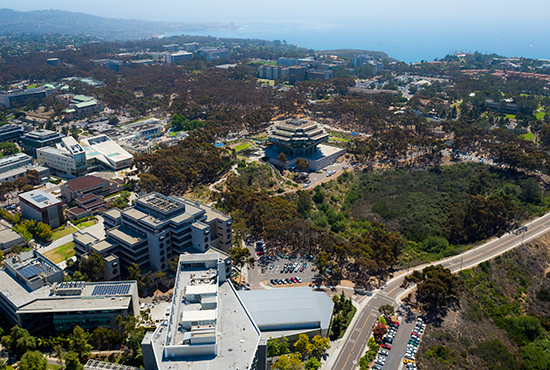The University of California San Diego today announced the next step in its Return to Learn program, which will guide an incremental repopulation of the campus while offering broad, asymptomatic testing for faculty, staff and students on a recurring basis to detect the presence of SARS-CoV-2, the novel coronavirus that causes COVID-19.
Return to Learn positioned UC San Diego as a nationwide leader in defining comprehensive and regular asymptomatic testing of students—and regular testing of infrastructure—as a strategy to reopen the campus.
The program incorporates elements of risk mitigation, viral monitoring and public health intervention to detect outbreaks early and reduce the risk of transmission.
UC San Diego plans for fall quarter, which begins Sept. 28, will include more than 4,750 lecture, lab and discussion course sections. Approximately 30 percent of courses will be conducted in person and the rest will be conducted in remote or hybrid formats.
“We aim to mitigate risk in a way that will allow UC San Diego to provide an environment for learning and offer a university experience that our students expect,” said Chancellor Pradeep K. Khosla. “As one of the nation’s leading research universities, we have risen to meet difficult circumstances and responded with innovation every step of the way.”
In addition to guidance from public health agencies, the Return to Learn program and other safety measures UC San Diego will implement are guided by scientific evidence and expertise from the UC San Diego School of Medicine and Wertheim School of Public Health and Longevity Science and healthcare experts from UC San Diego Health.
The initiative completed a successful pilot program in early June that helped determine that simple, self-testing of asymptomatic individuals is feasible.
Plans for the fall are to offer regular testing to students, faculty and staff for SARS-CoV-2. Higher testing frequencies are recommended for populations where social distancing is difficult or who are at higher risk of infection. Through implementation of strategies for adaptive testing, tracking, tracing and isolation, the goal is to lessen the likelihood of a significant outbreak on campus.
There will be no cost for asymptomatic or symptomatic testing of SARS-CoV-2 to students, faculty and staff if testing is done at a UC San Diego Health location or through Student Health Services. Testing details will be communicated in the near future by UC San Diego Health.
“Our adaptive model considers the most current science on transmission and infection risk and will drive our determinations on the testing frequency of our various campus populations,” said project lead Natasha Martin, Ph.D., associate professor of medicine at UC San Diego School of Medicine. “We wanted a simple, easy testing process which can be delivered at scale in the fall to ensure widespread testing for early outbreak detection.
“Our simulations indicate that if more than 75 percent of the population were tested per month, we would be able to detect an outbreak before there are 10 detectable infections on campus,” she said.
Students are expected to participate in SARS-CoV-2 testing upon their arrival to campus. These arrivals will be staggered to ensure adequate laboratory capacity. In the event an individual tests positive, isolation housing will be provided, and contact tracing will be performed in accordance with county health procedures. Moreover, all students who reside on campus will be expected to participate in daily symptom screening.
In addition to broad testing, policies focused on face coverings, social distancing and visitor symptom screening have been implemented and will be continuously reevaluated. Public areas and high-touch areas (door handles, elevator buttons, etc.) will be disinfected frequently.
A detailed list of new and updated safety measures are listed on the UC San Diego Return to Learn website.
In-person class size will be limited to fewer than 50 students per class, or 50 percent of classroom capacity (whichever number is smaller). Many in-person classes will have fewer than 25 students. Any classes with more than 50 students enrolled will be offered in a remote format. Lab and studio classes offered in person will observe room occupancy densities based on Centers for Disease Control and Prevention (CDC) and other public health guidelines.
In addition, on-campus housing communities and dining facilities will remain open and operational with enhanced precautionary measures to protect the health and well-being of students, faculty and staff.
If a student is coming to campus from an international location, CDC guidelines recommend a 14-day quarantine period. For UC San Diego students coming from abroad who have a housing contract, they can complete the quarantine period in specially designated on-campus housing with no additional housing fees.
Maintaining lower densities of individuals on campus is important to providing space for proper social distancing during the pandemic. For this reason, UC San Diego is taking an incremental approach to increasing the number of employees working on campus.
A return to the workplace for staff who have been working remotely will be determined according to the needs of students, patients, researchers and outreach personnel in accordance with state and county guidelines and supported by the UC San Diego Return to Learn program.
Ultimately, the campus is prepared to—at a very short notice—reduce or limit on-campus activities and move to fully remote teaching should pandemic conditions worsen at any point before the end of the quarter.
“As has been the case since the beginning of this unprecedented challenge, the university’s plans may change as the pandemic evolves,” Khosla said. “While the California reopening plan is executed and assessed at each phase, UC San Diego will notify faculty and staff of any changes to their work situation as appropriate. In all decisions, the health and safety of students, employees and local communities will be paramount.”
Khosla continued, “I am truly proud of our Triton community, which has shown remarkable commitment, dedication, resiliency and innovation in these challenging times.”
For the latest updates on UC San Diego’s campus repopulation plan, please visit the Return to Learn website.
Original post https://alertarticles.info
